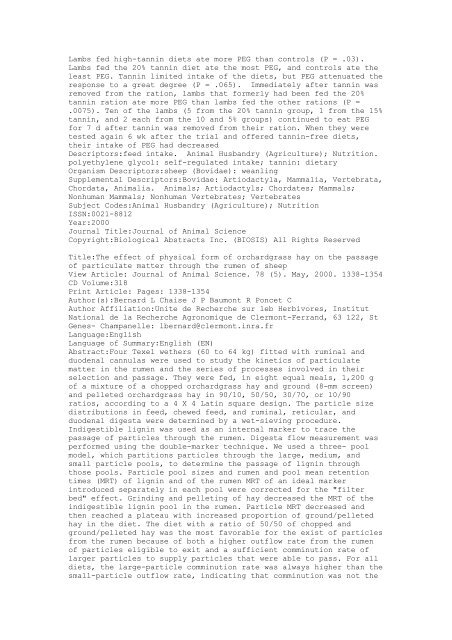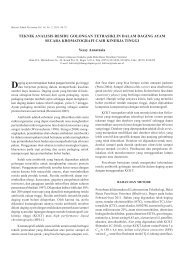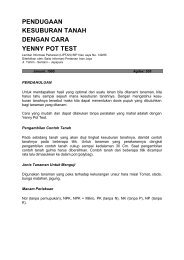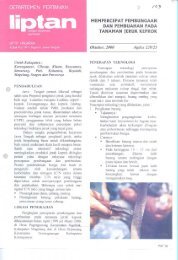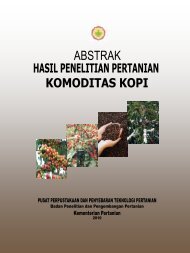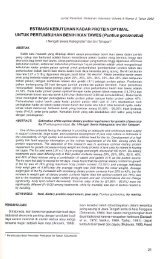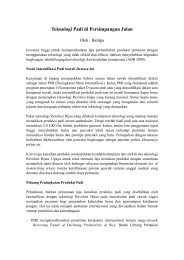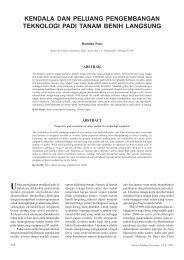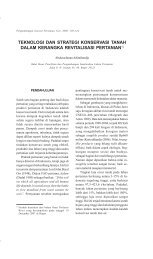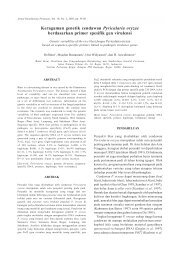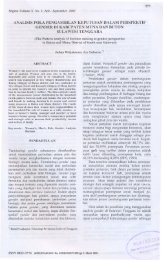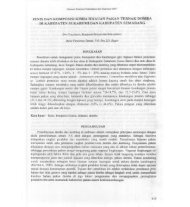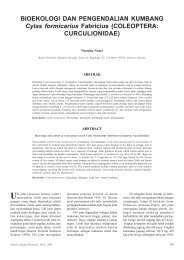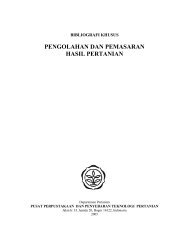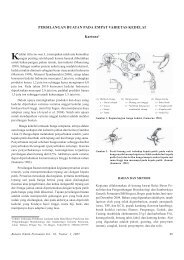Komoditas : KAMBING - Pustaka
Komoditas : KAMBING - Pustaka
Komoditas : KAMBING - Pustaka
Create successful ePaper yourself
Turn your PDF publications into a flip-book with our unique Google optimized e-Paper software.
Lambs fed high-tannin diets ate more PEG than controls (P = .03).<br />
Lambs fed the 20% tannin diet ate the most PEG, and controls ate the<br />
least PEG. Tannin limited intake of the diets, but PEG attenuated the<br />
response to a great degree (P = .065). Immediately after tannin was<br />
removed from the ration, lambs that formerly had been fed the 20%<br />
tannin ration ate more PEG than lambs fed the other rations (P =<br />
.0075). Ten of the lambs (5 from the 20% tannin group, 1 from the 15%<br />
tannin, and 2 each from the 10 and 5% groups) continued to eat PEG<br />
for 7 d after tannin was removed from their ration. When they were<br />
tested again 6 wk after the trial and offered tannin-free diets,<br />
their intake of PEG had decreased<br />
Descriptors:feed intake. Animal Husbandry (Agriculture); Nutrition.<br />
polyethylene glycol: self-regulated intake; tannin: dietary<br />
Organism Descriptors:sheep (Bovidae): weanling<br />
Supplemental Descriptors:Bovidae: Artiodactyla, Mammalia, Vertebrata,<br />
Chordata, Animalia. Animals; Artiodactyls; Chordates; Mammals;<br />
Nonhuman Mammals; Nonhuman Vertebrates; Vertebrates<br />
Subject Codes:Animal Husbandry (Agriculture); Nutrition<br />
ISSN:0021-8812<br />
Year:2000<br />
Journal Title:Journal of Animal Science<br />
Copyright:Biological Abstracts Inc. (BIOSIS) All Rights Reserved<br />
Title:The effect of physical form of orchardgrass hay on the passage<br />
of particulate matter through the rumen of sheep<br />
View Article: Journal of Animal Science. 78 (5). May, 2000. 1338-1354<br />
CD Volume:318<br />
Print Article: Pages: 1338-1354<br />
Author(s):Bernard L Chaise J P Baumont R Poncet C<br />
Author Affiliation:Unite de Recherche sur leb Herbivores, Institut<br />
National de la Recherche Agronomique de Clermont-Ferrand, 63 122, St<br />
Genes- Champanelle: lbernard@clermont.inra.fr<br />
Language:English<br />
Language of Summary:English (EN)<br />
Abstract:Four Texel wethers (60 to 64 kg) fitted with ruminal and<br />
duodenal cannulas were used to study the kinetics of particulate<br />
matter in the rumen and the series of processes involved in their<br />
selection and passage. They were fed, in eight equal meals, 1,200 g<br />
of a mixture of a chopped orchardgrass hay and ground (8-mm screen)<br />
and pelleted orchardgrass hay in 90/10, 50/50, 30/70, or 10/90<br />
ratios, according to a 4 X 4 Latin square design. The particle size<br />
distributions in feed, chewed feed, and ruminal, reticular, and<br />
duodenal digesta were determined by a wet-sieving procedure.<br />
Indigestible lignin was used as an internal marker to trace the<br />
passage of particles through the rumen. Digesta flow measurement was<br />
performed using the double-marker technique. We used a three- pool<br />
model, which partitions particles through the large, medium, and<br />
small particle pools, to determine the passage of lignin through<br />
those pools. Particle pool sizes and rumen and pool mean retention<br />
times (MRT) of lignin and of the rumen MRT of an ideal marker<br />
introduced separately in each pool were corrected for the "filter<br />
bed" effect. Grinding and pelleting of hay decreased the MRT of the<br />
indigestible lignin pool in the rumen. Particle MRT decreased and<br />
then reached a plateau with increased proportion of ground/pelleted<br />
hay in the diet. The diet with a ratio of 50/50 of chopped and<br />
ground/pelleted hay was the most favorable for the exist of particles<br />
from the rumen because of both a higher outflow rate from the rumen<br />
of particles eligible to exit and a sufficient comminution rate of<br />
larger particles to supply particles that were able to pass. For all<br />
diets, the large-particle comminution rate was always higher than the<br />
small-particle outflow rate, indicating that comminution was not the


